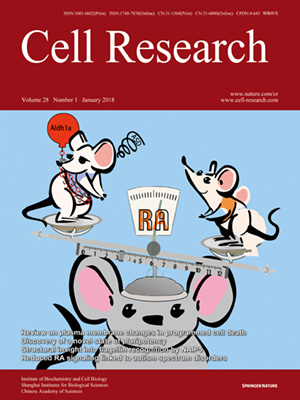
Volume 28, No 1, Jan 2018
ISSN: 1001-0602
EISSN: 1748-7838 2018
impact factor 17.848*
(Clarivate Analytics, 2019)
Volume 28 Issue 1, January 2018: 90-110 | Open Access
ORIGINAL ARTICLES
PRRT2 deficiency induces paroxysmal kinesigenic dyskinesia by regulating synaptic transmission in cerebellum
Guo-He Tan1,2,*, Yuan-Yuan Liu1,*, Lu Wang1,*, Kui Li1,*, Ze-Qiang Zhang1,3, Hong-Fu Li4, Zhong-Fei Yang1, Yang Li1, Dan Li1, Ming-Yue Wu1, Chun-Lei Yu5, Juan-Juan Long6, Ren-Chao Chen1, Li-Xi Li4, Lu-Ping Yin1, Ji-Wei Liu1, Xue-Wen Cheng1, Qi Shen1, You-Sheng Shu1, Kenji Sakimura7, Lu-Jian Liao5,#, Zhi-Ying Wu4,# and Zhi-Qi Xiong1,3
1Institute of Neuroscience and State Key Laboratory of Neuroscience, CAS Center for Excellence in Brain Science and Intelligence Technology, Shanghai Institutes for Biological Sciences, Chinese Academy of Sciences, Shanghai 200031, China
2Department of Human Anatomy, Guangxi Key Laboratory of Regenerative Medicine & Guangxi Collaborative Innovation Center of Biomedicine, Guangxi Medical University, Nanning, Guangxi 530021, China
3University of Chinese Academy of Sciences, Beijing 100049, China
4Department of Neurology and Research Center of Neurology, Second Affiliated Hospital, Zhejiang University School of Medicine, Hangzhou, Zhejiang 310009, China
5Shanghai Key Laboratory of Regulatory Biology, School of Life Sciences, East China Normal University, Shanghai 200241, China
6Institute of Biochemistry and Cell Biology, Shanghai Institutes for Biological Sciences, Chinese Academy of Sciences, Shanghai 200031, China
7Department of Cellular Neurobiology, Brain Research Institute, Niigata University, Niigata 951-8585, Japan
Correspondence: Zhi-Qi Xiong,(xiongzhiqi@ion.ac.cn)
Mutations in the proline-rich transmembrane protein 2 (PRRT2) are associated with paroxysmal kinesigenic dyskinesia (PKD) and several other paroxysmal neurological diseases, but the PRRT2 function and pathogenic mechanisms remain largely obscure. Here we show that PRRT2 is a presynaptic protein that interacts with components of the SNARE complex and downregulates its formation. Loss-of-function mutant mice showed PKD-like phenotypes triggered by generalized seizures, hyperthermia, or optogenetic stimulation of the cerebellum. Mutant mice with specific PRRT2 deletion in cerebellar granule cells (GCs) recapitulate the behavioral phenotypes seen in Prrt2-null mice. Furthermore, recording made in cerebellar slices showed that optogenetic stimulation of GCs results in transient elevation followed by suppression of Purkinje cell firing. The anticonvulsant drug carbamazepine used in PKD treatment also relieved PKD-like behaviors in mutant mice. Together, our findings identify PRRT2 as a novel regulator of the SNARE complex and provide a circuit mechanism underlying the PRRT2-related behaviors.
10.1038/cr.2017.128
FULL TEXT | PDF
Browse 1557


